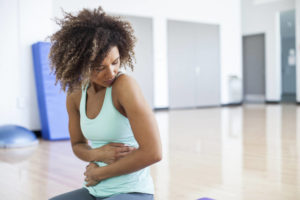
Crohn’s Disease is a type of inflammatory bowel disease in which the body’s immune system attacks the gastrointestinal tract. It can affect any part of the gastrointestinal tract, from mouth to anus.
Because the disease’s effects vary, people with the disease experience it differently. The cause is unknown, but believed to be due to a combination of environmental, immune, and bacterial factors in genetically susceptible individuals.
Signs and symptoms vary and can include defecation, fever, weight loss, abdominal pain, fatigue, and diarrhea. Most people experience these symptoms years before diagnosis, which is usually onset between 15 and 30 years of age (although it can occur at any age).
While there is no medication or surgical procedures that can cure Crohn’s, treatments can help alleviate symptoms and maintain remission. Several studies have found exercise to be an important part of managing Crohn’s, but because the disease affects its carriers differently, one fitness regimen does not fit all.
It’s also found that certain types of exercises can trigger an increase in secretions in the digestive system (ultimately causing a bowel movement). Of course, the most important thing is to talk to a doctor before hopping into a new fitness routine to get the green light.
Health professionals recommend Crohn’s patients skip the high-intensity workouts and opt for low and no-impact exercises. It’s also recommended that Crohn’s patients avoid heavy meals (and are aware of the nearest bathroom) before physical activity, leaving at least a couple hours between eating and exercising. By opting for the right exercises and modalities, patients can experience reduced stress levels and overall better quality of life.
Once diagnosed, patients are prescribed medications that can help with inflammation and discomfort. This, in combination with a recommended exercise program, may actually send a patient into remission given the severity of that person’s case.
With any illness, it seems that exercise helps to cut sickness rate or shortens the period during which we may be sick. And although fitness is not a magical pill for Crohn’s disease, it’s no different here.
Strength training can help improve bone density in Crohn’s patients who have experienced osteopenia or osteoporosis. If your doctor gives the green light for strength training, you can find a trainer, preferably one familiar with Crohn’s disease, and program a personalized fitness routine to help improve bone density, muscle strength, overall stamina, and stress relief.
Cycling or Spinning is an option for those looking to get into aerobic work without triggering symptoms. Some patients may find that they can cycle to the point of exhaustion without experiencing symptoms.
Swimming has both mental and physical benefits, which makes it another good fitness option. It’s a low-stress way to move the body and is actually quite calming, which can lead to longer exercise time. It’s also great for joint health (which matters because arthritis is associated with Crohn’s cases).
Walking is a great option for those living with Crohn’s disease. Other aerobic exercises may be too high-impact and can cause pain, bleeding, and diarrhea. Walking is low-impact and is a great place to start for those who previously lived a mostly sedentary lifestyle.
Dancing, although aerobic, is a good option because it helps with stress reduction. As long as the movement is low-impact it can help Crohn’s patients by fighting depression and stress and staying hydrated.
Pilates and Yoga! These two fitness modalities are low-impact and help build strength and mobility. Both modalities are known to reduce stress and can help to decrease inflammation.
If you’re living with Crohn’s disease, it’s important to stay encouraged. There may not be a cure, but there are natural and holistic ways to help improve your quality of life, starting with physical fitness.
 Jasmine Danielle is the Associate Editor of BlackDoctor.org. She received her BFA in Dance Education & Performance from the University of Illinois at Urbana-Champaign and has since done work as a certified fitness & wellness educator, blogger, dancer, and designer.
Jasmine Danielle is the Associate Editor of BlackDoctor.org. She received her BFA in Dance Education & Performance from the University of Illinois at Urbana-Champaign and has since done work as a certified fitness & wellness educator, blogger, dancer, and designer.









